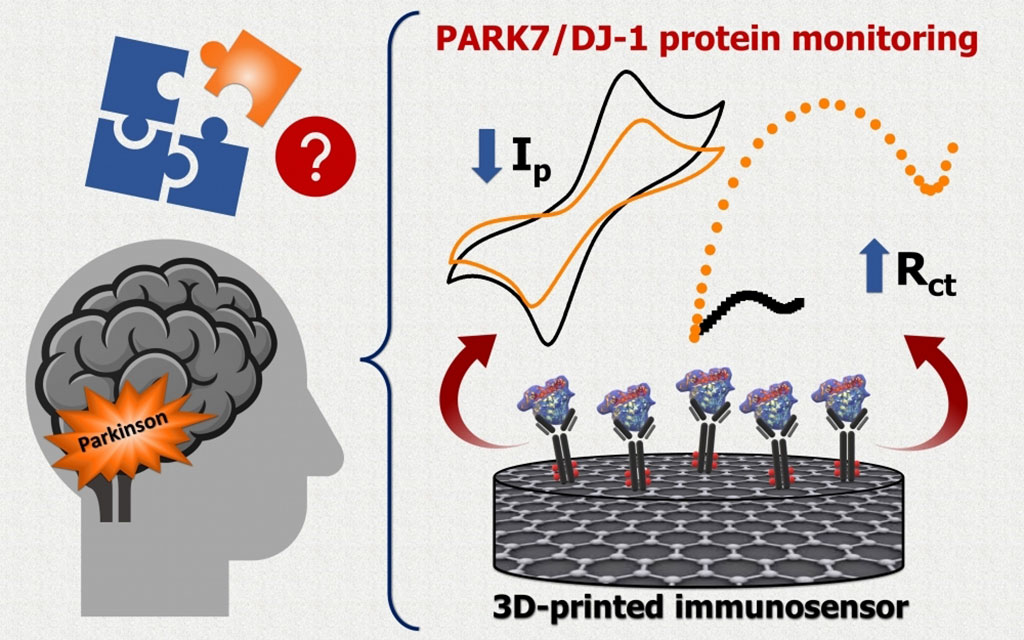Electrochemical Sensor Detects Early-Stage Parkinson’s in Blood Samples
Posted on 17 Apr 2023
Creating biosensors that provide quick and dependable results is crucial for accurately diagnosing diseases. In the case of neurodegenerative diseases like Parkinson's, early detection enables prompt treatment, which increases the likelihood of successful recovery. One method for identifying and tracking the progression of Parkinson's disease involves monitoring the levels of the DJ-1 protein. When the levels of the DJ-1 protein are low, it may indicate dysregulation of the PARK7 gene expression. Now, a 3D-printed immunosensor based on treated graphene conducting filament has been developed by researchers as a proof-of-concept for detecting PARK7/DJ-1 protein levels, with the aim of diagnosing Parkinson's.
Researchers at the University of Campinas (UNICAMP, Campinas, Brazil) and the Federal University of São Carlos (UFSCar, São Carlos, Brazil) used a standard 3D printer to create an electrochemical sensor that can detect Parkinson's disease at various, showcasing its potential for early diagnosis and as a template for identifying other illnesses. The sensor was constructed using a commercial filament composed primarily of polylactic acid (PLA), a biodegradable polymer, combined with a conductive material (graphene) and additional additives. By employing additive manufacturing, three electrodes were printed onto the plastic substrate and then chemically treated to enhance their conductivity and promote the formation of a surface layer of functional groups (carboxyls) that bind to antibodies.

The activation process involved removing the polymeric insulating surface from the electrodes by immersing them in sodium hydroxide (NaOH) and applying an electric potential (positive and negative). This led to a reaction between antibodies and PARK7/DJ-1, resulting in a diagnosis. Specific antibodies for PARK7/DJ-1 were immobilized on the electrode surfaces, and the sensor was utilized to detect the protein at three concentrations: 30 μg/L, 40 μg/L, and 100 μg/L. The average level in patients diagnosed with Parkinson's at different stages is approximately 30 ± 9 μg/L.
The study's primary contribution is as a proof of concept, demonstrating the versatility of 3D printing in creating a platform for immobilizing biomolecules. The researchers believe that this platform could be applied to diagnose other diseases. In the case of PARK7/DJ-1, the protein is linked to type 2 diabetes, infertility, certain cancers, and neurological disorders. The goal is to expand its use to other biomarkers, and the team is currently developing a sensor to diagnose yellow fever.
“The sensor rapidly indicates the level of the protein PARK7/DJ-1 in human blood and synthetic cerebrospinal fluid. The molecule is associated with Parkinson’s at levels below 40 micrograms per liter [40 μg/L],” said Cristiane Kalinke, first author. “It can be printed in various shapes and sizes. It can also be miniaturized to create a genuinely portable device that requires a very small sample.”
“We decided to design and produce a very simple device that was cheap and could be used for continual monitoring, with alerts for physicians and patients if there were alterations in the level of PARK7/DJ-1, which is especially useful when analyzed in conjunction with other biomarkers,” said Juliano Alves Bonacin, professor in the Department of Inorganic Chemistry at IQ-UNICAMP. “Imagine there’s an outbreak of a certain disease in a particular area. With a few 3D printers and some electrodes, it would be possible to produce a sensor like ours on site.”














